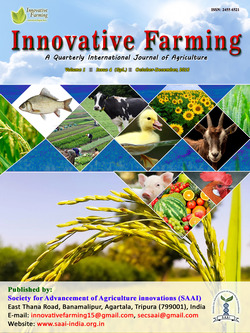
Early Sprouting Mulberry Genotype - A Boon for Spring Season Silkworm Rearing in North West India
Santoshkumar Magadum*
Regional Sericultural Research Station, Central Silk Board, CSB Complex, Miran Sahib, Jammu- 181101 (J&K), INDIA
Sardar Singh
Regional Sericultural Research Station, Central Silk Board, CSB Complex, Miran Sahib, Jammu- 181101 (J&K), INDIA
DOI: NIL
Keywords: Mulberry, Early sprouting, Sericulture, Chawki silkworms
Abstract
The early sprouting mulberry genotype is an advantage for on time spring crop rearing in the states of NW India because any delay in bivoltine rearing in spring season adversely affects cocoon production. The mulberry varieties which sprout early during the onset of spring season with long photoperiodic conditions are recognized as early sprouting genotype. Early sprouters are preferred for feeding silkworms in the spring season, because they give sufficient quantity of leaves on time in March. With rise in temperature in April, the season becomes unfavorable for silkworm rearing. The sprouting duration of various mulberry varieties in NW India ranges from 33-52 days after winter pruning whereas it takes 11-15 days after monsoon pruning. Normally mulberry varieties take more time for sprouting after winter pruning due to winter dormancy and photoperiodic conditions. Soil moisture plays an important role in leaf bud break after winter dormancy. It needs both increasing temperature and tissue wetting for bud break and shoot emergence to occur with onset of spring season. The mulberry varieties differ in their requirement of moisture and temperature for leaf sprouting and growth. Photoperiod also exerts a considerable influence in the leaf bud break of mulberry. An optimum period of 11 hours illumination is desirable. Increase in the day length use to be observed from February, which coincides with leaf bud break in early sprouting genotypes of mulberry. Photoperiod requirement of different varieties may differ as a result, the early sprouting genotype requires less duration of light to sprout in comparison with other genotypes. The early sprouting mulberry genotypes are useful for feeding chawki silkworms at Chawki Rearing Centres to synchronize adult age rearing with leaf maturity in the field on already existing mulberry trees, which usually sprout late. By on time distribution of chawki silkworms, the cocoon yield in the field improves considerably.
Downloads
not found
Reference
Chandrashekar, S., B.G. Prakash and H.M. Shaila. 2001. Evaluation of different mulberry varieties with respect to establishment and yield. In: Proceedings of National Seminaron Mulberry Sericulture Research, KSSR&DI, Bangalore, India,November 26 – 28, pp. 99.
Dandin, S.B. and R. Kumar. 1989. Evaluation of mulberry genotypes for different growth and yield parameters. In:Genetic resources of mulberry and utilization. (Eds). Sengupta, K. and S.B. Dandin, CSR&TI, Mysore, pp. 143-151.
Downs, R.J and H.A. Borthwick. 1956. Effect of photoperiod on growth of trees. Botanical Gazette, 117: 310–326.
Eswar Rao, M.S., R.S. Mallikarjunappa and S.B. Dandin. 2000. Evaluation of tetraploid and triploid mulberry genotypes for propagation, growth and leaf yield parameters. In: Proceedings of National Conference on Strategic Sericultural Research and Development, CSR&TI, Mysore, India,November, 16-18,pp. 2.
Jolly, M.S. and S.B. Dandin. 1986. Collection, conservation and evaluation of mulberry (Morus spp.) germplasm. C.S.R & T.I., Mysore, India, pp.1-43.
Koul, A. 2006. Mulberry leaf sprouting as an indicator of spring rearing. Journal of Research, SKUAST-J, 5(2): 173-178.
Kramer, P.J. 1936. Effects of variation in length of day on growth and dormancy of trees. Plant Physiology, 11:127–137.
Kramer, P.J. and T.T. Kozlowski. 1979. Physiology of woody plants. Academic Press, New York, San Francisco, London, pp. 258-281.
Miflin, B.J. and P.J. Lea. 1977. Amino acid metabolism. Annual Review of Plant Physiology. 28: 299-329.
Murthy, V.N.Y., H.L. Ramesh, Munirajappa and B.R.D. Yadav. 2012. Screening of selected mulberry (Morus) germplasm varieties through propagation parameters. Journal of Natural Sciences Research. 2(5): 96-106.
Pandey, R.K. 2013. FYT-99/G4, an early sprouting Morus alba genotype for north western India. http://silkwormmori.blogspot.com/2013/10/fyt-99g4-early-sprouting-morus-alba.html.
Patil, S.G.V. 2002. Evaluation of promising genotype S1635 under irrigated conditions. Indian Silk, 41(2): 7-9.
Sakai, A. and W. Larcher. 1987. Cold acclimation in plants. In: Ecological Studies, (Eds). Billings, W.D., F. Golley, O.L. Lange, J.S. Olson and H. Remmert. Springer-Verlag, Berlin, pp. 97-l37.
Sujathamma, P. and S.B. Dandin. 1998. Evaluation of mulberry (Morus spp.) genotypes of propagation parameters. Indian Journal of Sericulture. 37(2): 133-136.
Susheelamma, B.N., M.S. Jolly, K. Giridharand K. Sengupta. 1990. Evaluation of germplasm genotypes for drought resistance in mulberry. Sericologia, 30(3): 327-341.
